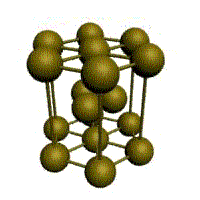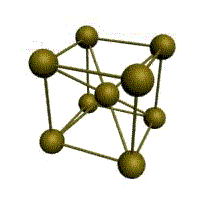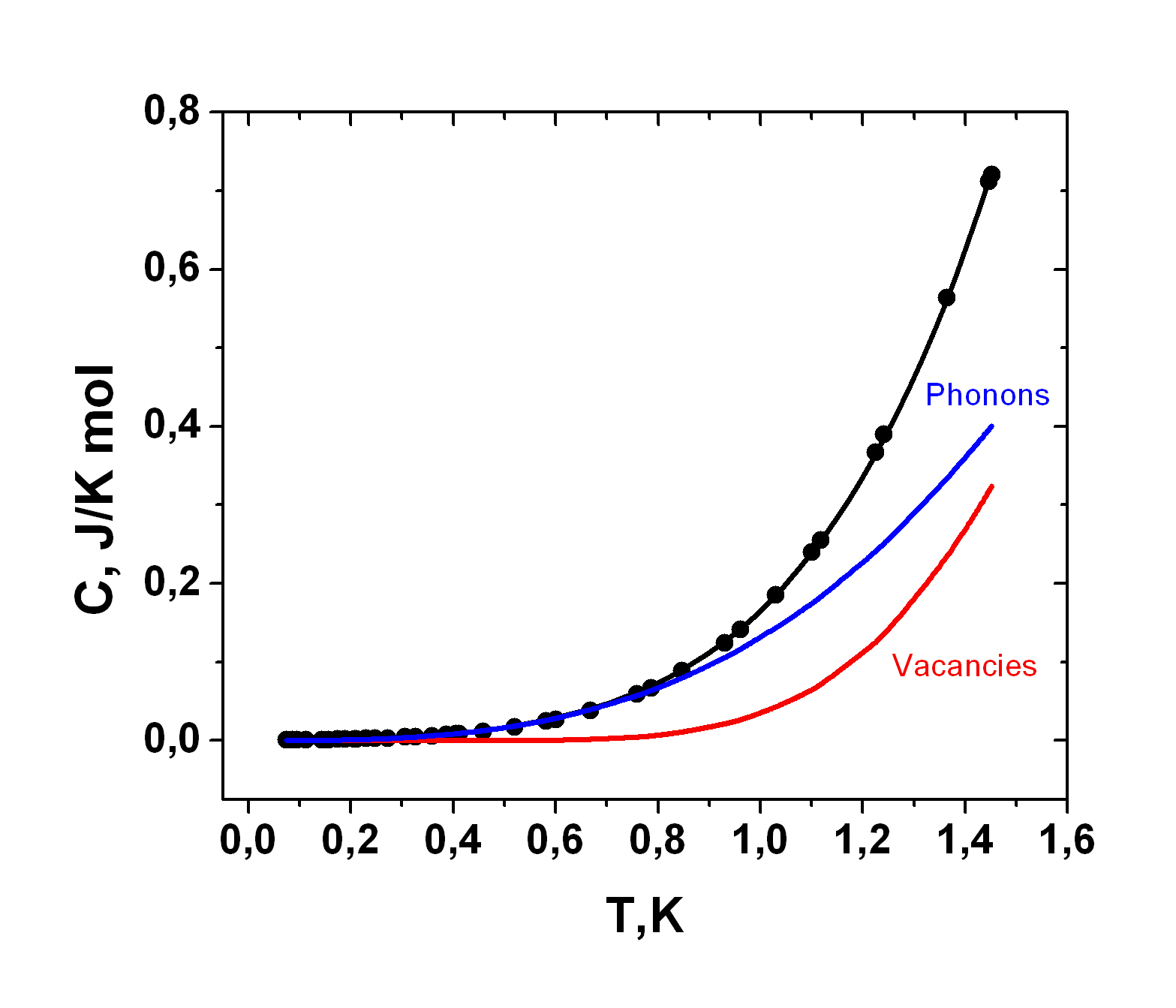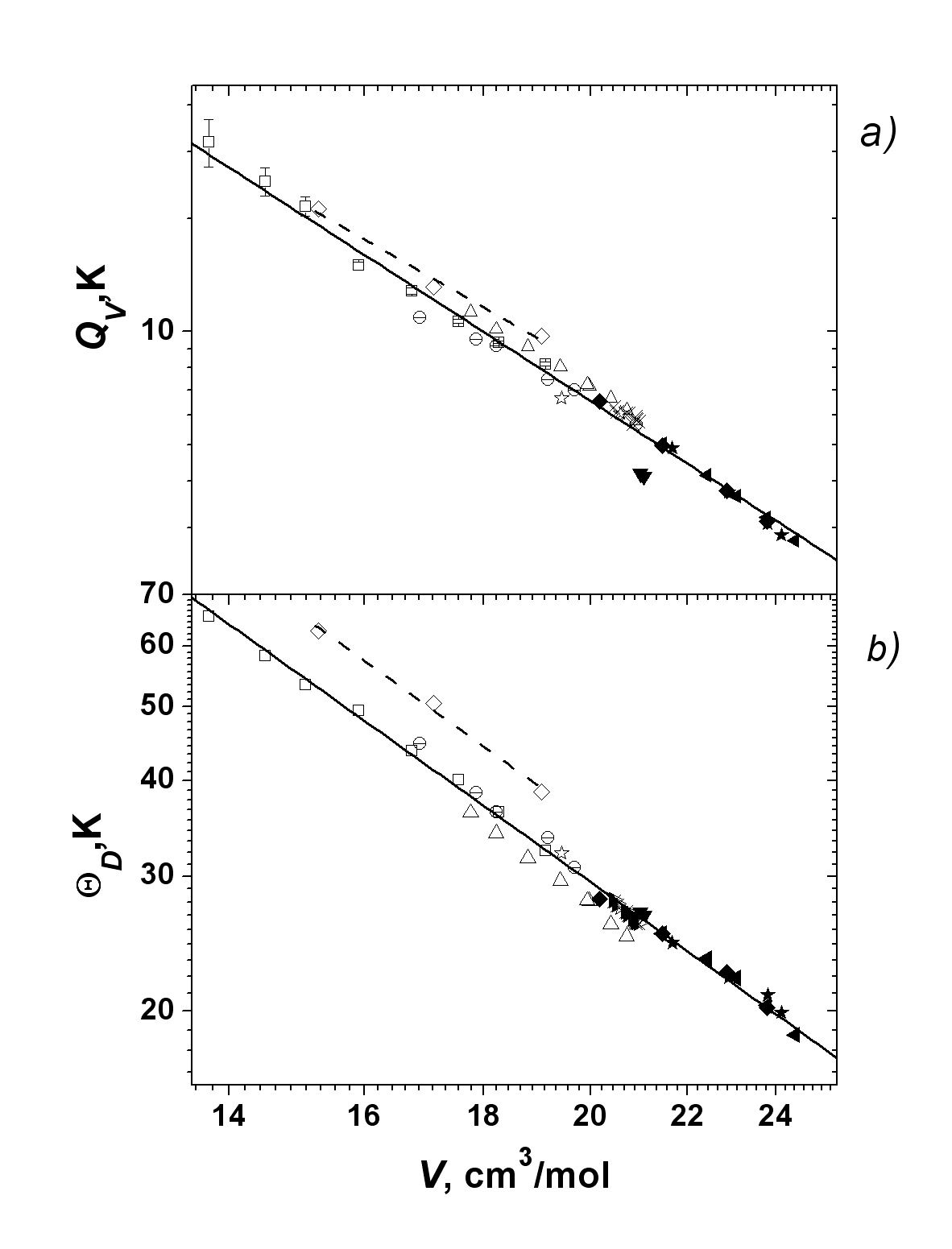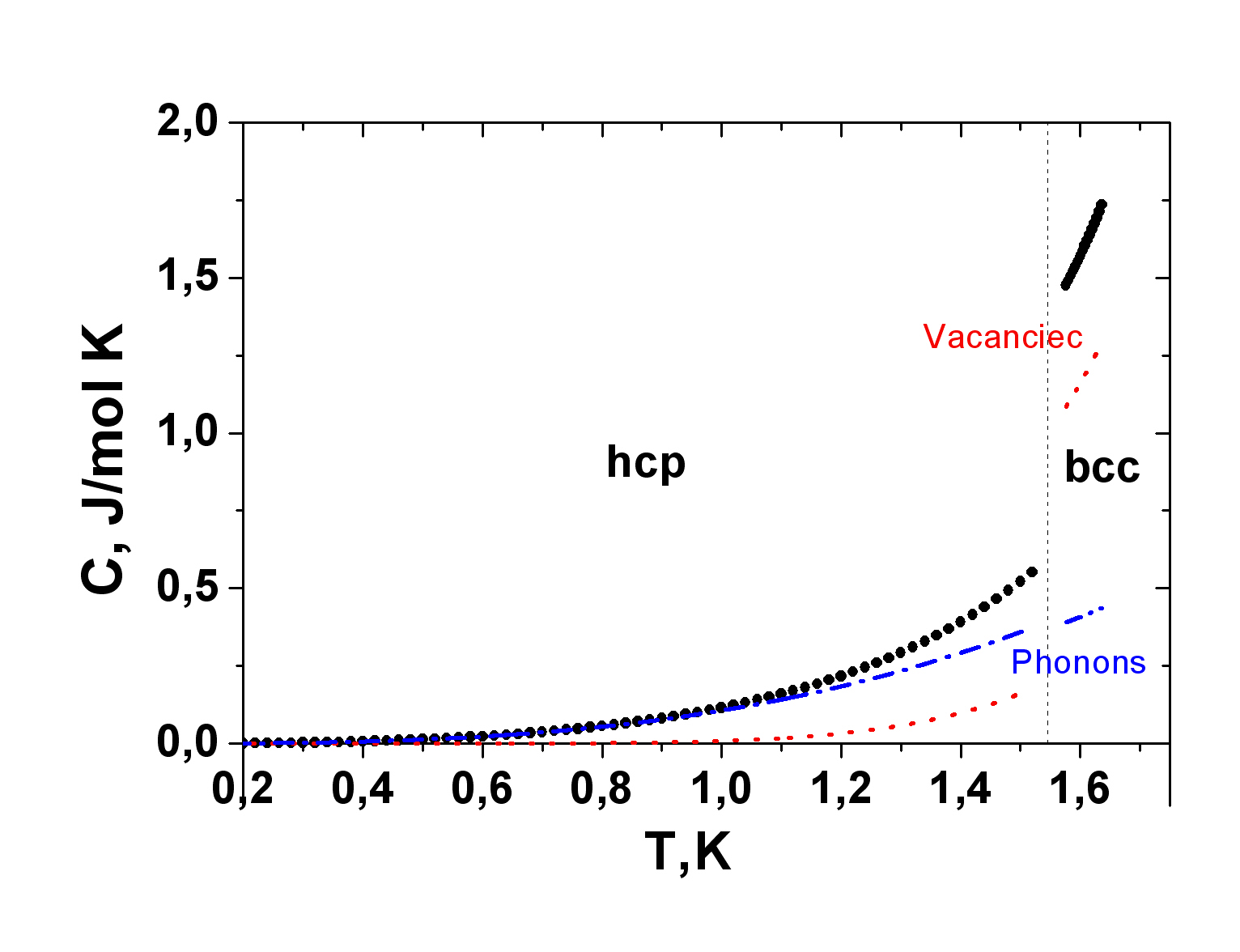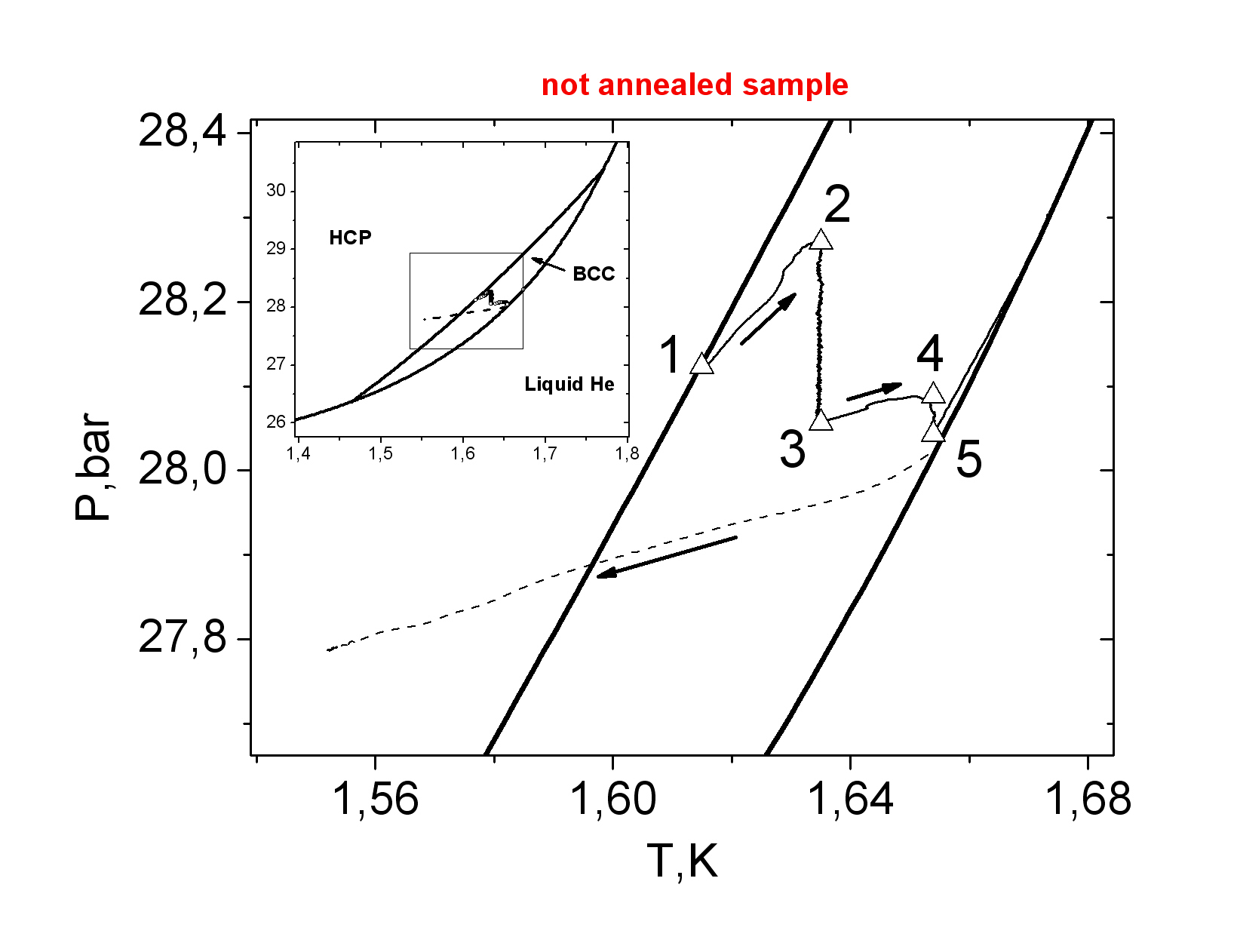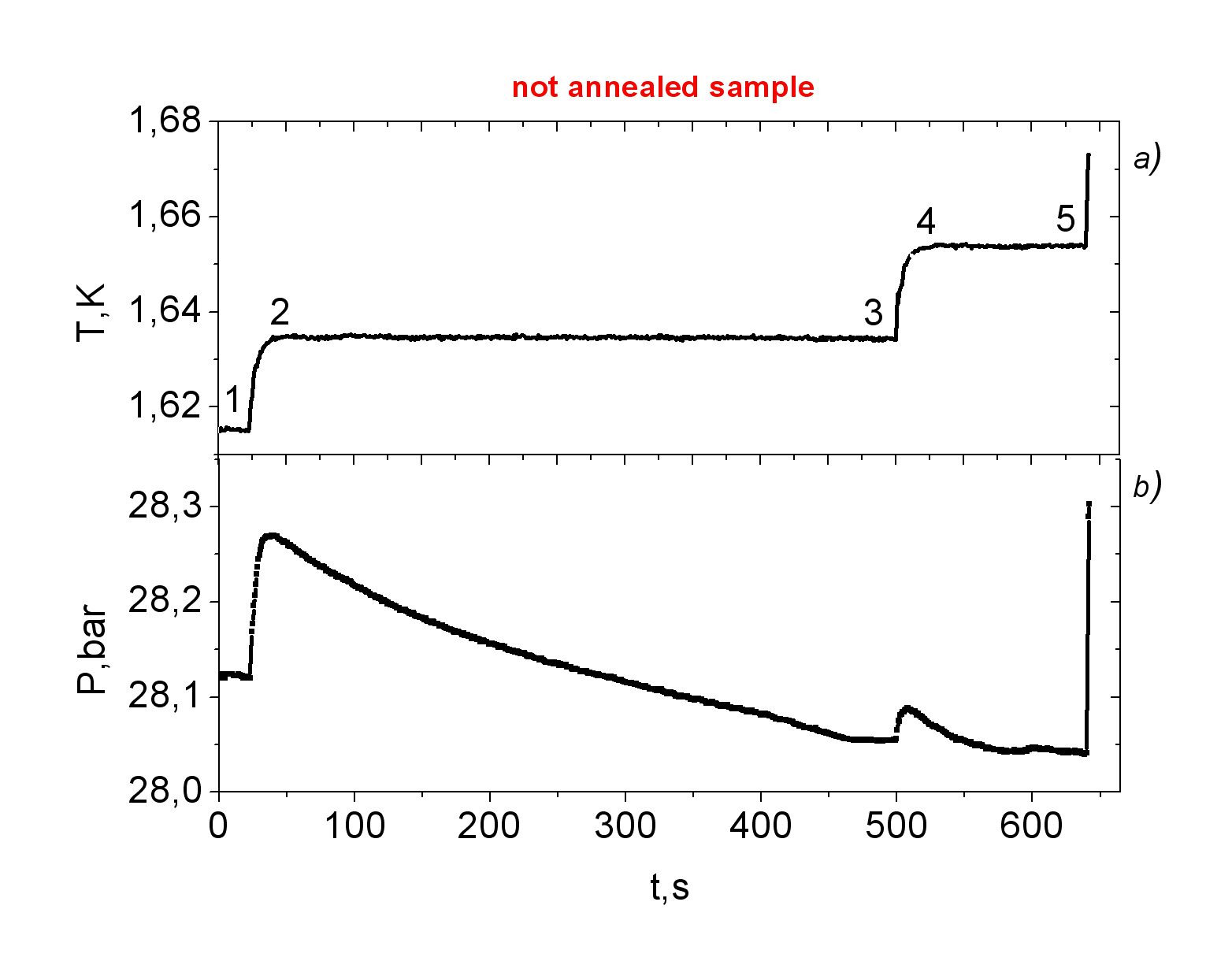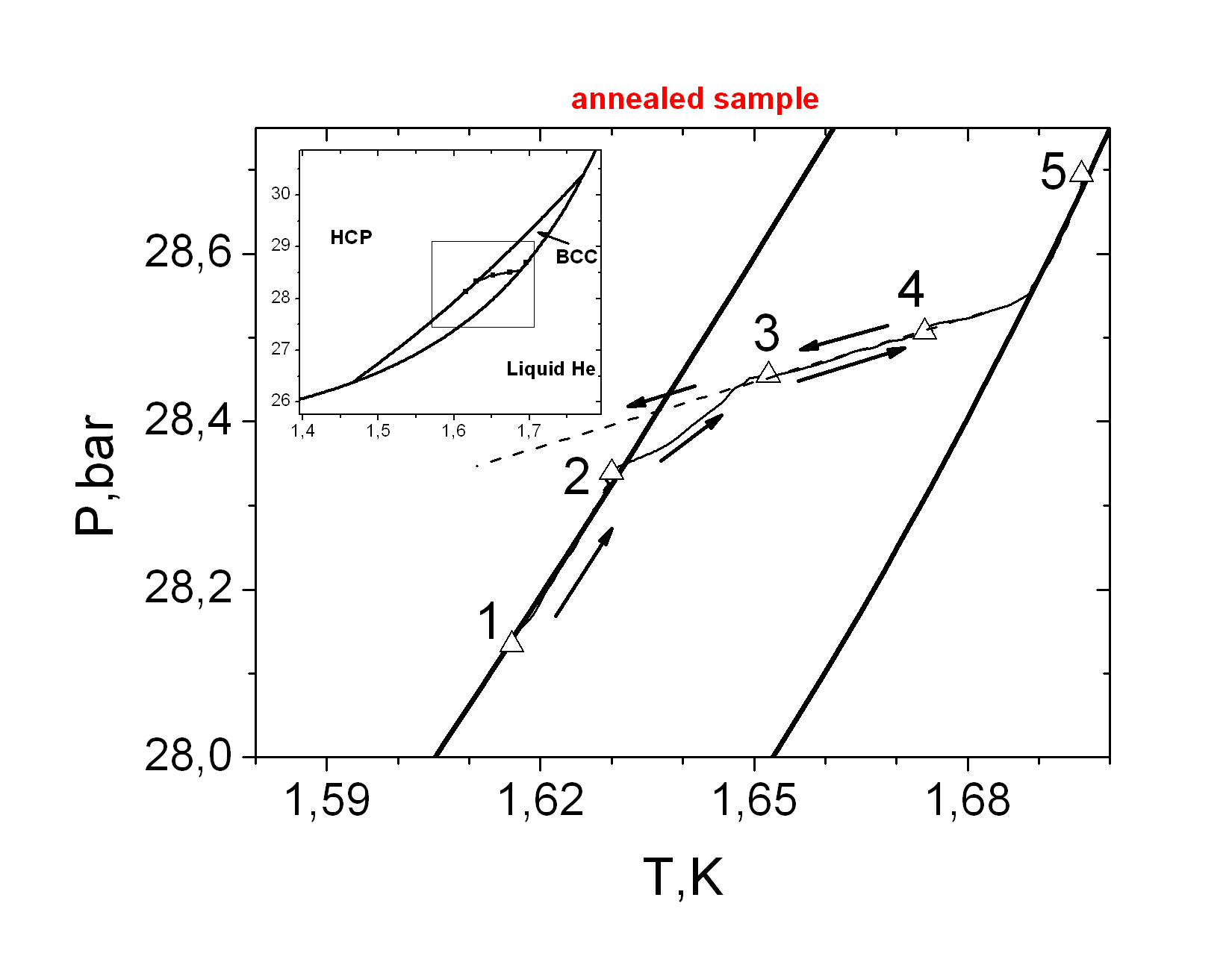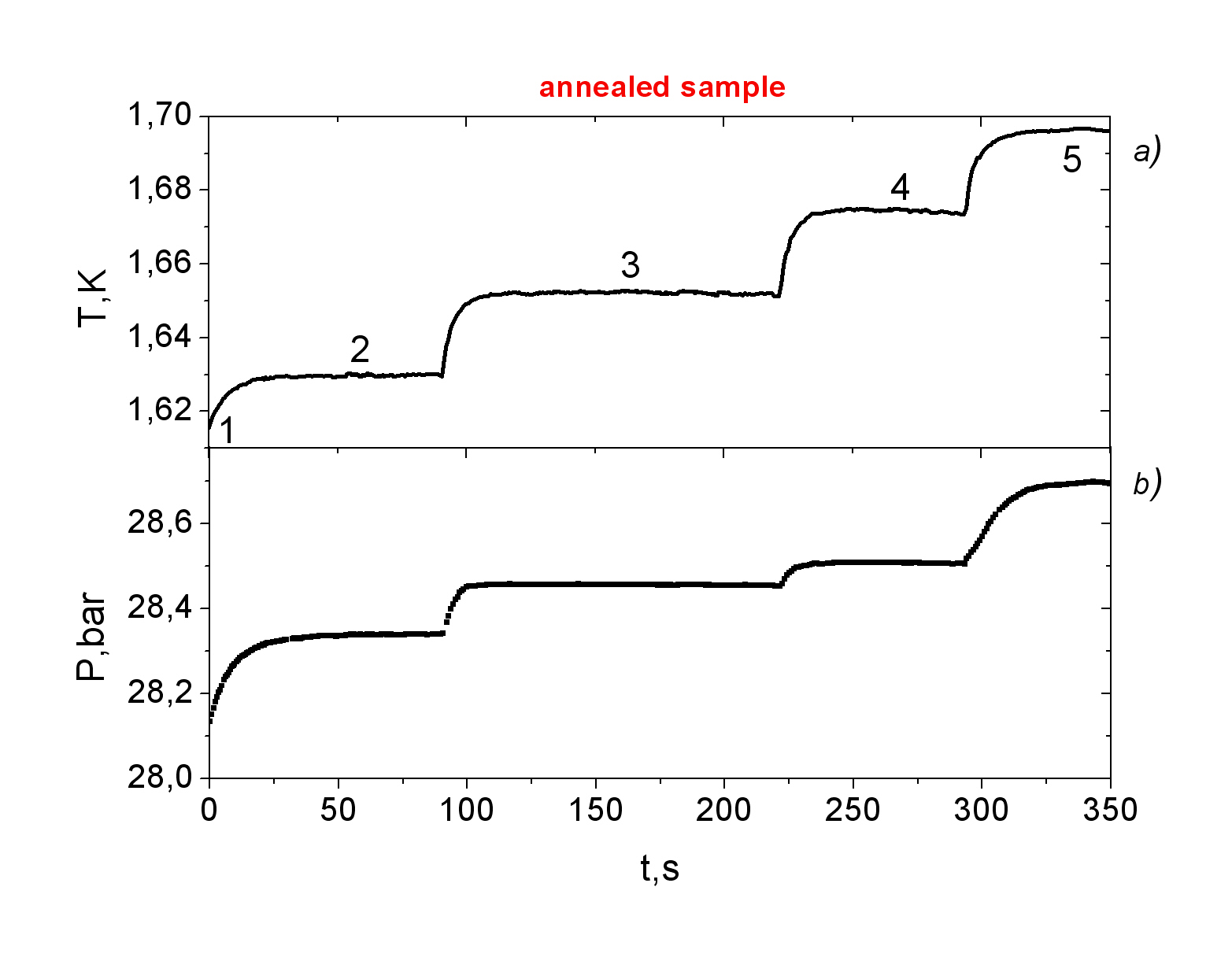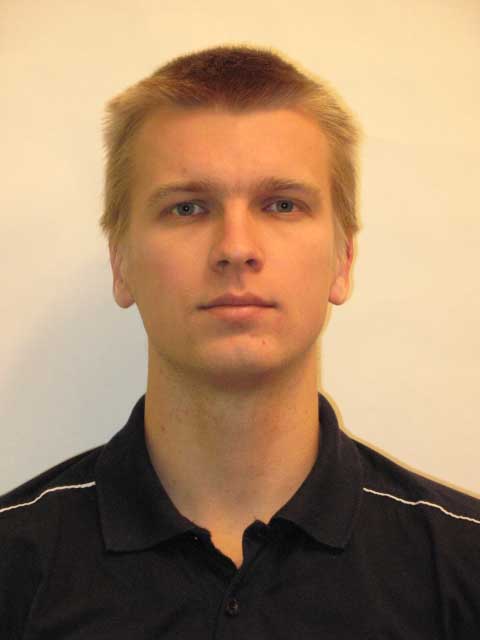| Menu |
|
|
 |
|
Quantum crystals bcc-hcp phase transition in solid helium | Experimental methods: - Precise pressure measurements
- Nuclear magnetic resonance (NMR)
| Our experimental cell 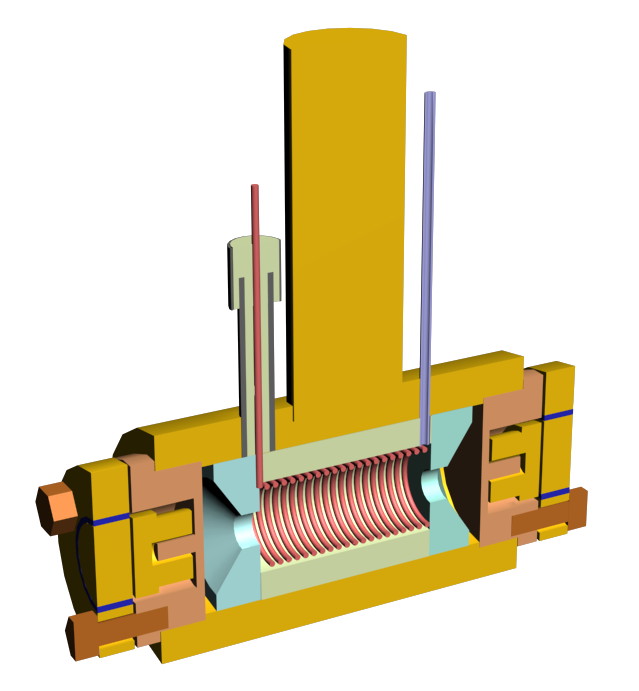 |
___________________________________________________
Transformation of 4He to 3He P-T phase diagram
___________________________________________________ Participation on the Conferences
QFS2010 - International Symposium on Quantum Fluids and Solids, August 1-7, 2010 - CNRS/UJF, Institut Néel, Grenoble, France - "Vacancy Nature of the bcc Phase in Solid Helium" (poster pdf), "The Effect of Crystal Quality on hcp Phase Nucleation in bcc 4He Overcooled." (poster pdf)
QFS2009 - International Symposium on Quantum Fluids and Solids, August 5-11, 2009 - Northwestern University, Evanston, Illinois, USA. Reports - "Fast Diffusion Process in Quenched hcp Dilute Solid 3He-4He Mixture" (poster pdf), "The Hysteresis of bcc-hcp Transition in Solid 3He-4He Mixture" (poster pdf)
ULT2008 - International Conference, Frontiers of Low Temperature Physics, August 14-17, 2008, London, Egham, UK. Report – «bcc-hcp phase coexisting range in dilute 3He-4He solid mixture»
LT25 - 25th International Conference on Low Temperature Physics, August 6-13, 2008, Amsterdam, the Netherlands. Report – «P-T phase diagram features for 1% 3He - 4He solid mixtures in the bcc-hcp region» and report - «Effect of 3He impurities on the bcc-hcp phase transition in 4He crystals»
QFS2007 - International Symposium on Quantum Fluids and Solids, August 1-6, 2007, Kazan, Russia. Report – «New peculiarities of the bcc-hcp transition in solid helium» and report - «The bcc-hcp Phase Transition in 4He: Comparison with Theory of Homogene-ous Nucleation»
CC-2006 - Sixth International Conference on Cryocrystals and Quantum Crystals, September 3-7, 2006, Kharkov, Ukraine. Report – «The Kinetic Features of Supercooled BCC Helium-4»
QFS2006 - International Symposium on Quantum Fluids and Solids, August 1-6, 2006, Kyoto, Japan. Report – «Effect of Crystal Quality on HCP-BCC Phase Transition in Solid He» and report - «Vacancy and Phonon Contributions to Pres-sure of Solid 4He» CMD21 - 21st General Conference EPS Condensed Matter Division, March 27-31, 2006, Dresden, Germany, P. 555. Report - «The Kinetics Asymmetry of the BCC-HCP Phase Transition in Solid Helium-4» LT24 - 24th International Conference on Low Temperature Physics, August 10-17, 2005, Orlando, Florida USA, P.154. Report - «Kinetics of Phase Transition at the BCC-HCP-Liquid Triple Points of 4He» 3rd International Conference Phys. Liq. Matt.: Modern Problems: Abstracts, May 27-31, 2005 Kyiv, Ukraine, P. 231. Report - «The role of liquid he-lium at BCC-HCP phase transition in 3He – 4He systems» ____________________________________
The main results
Transformation of liquid-like inclusions quenched in solid helium to a new (disordered?) state with anomalously short spin-spin relaxation time.
[N.P. Mikhin, A.P. Birchenko, A.S. Neoneta, E.Ya. Rudavskii, and Ye.O. Vekhov. NMR Study of Disordered Inclusions in the Quenched Solid Helium //arXiv:1107.0653v1]
Studying of liquid-like inclusions in rapidly quenched solid helium samples depending on crystallization rate. [N.P. Mikhin, A.P. Birchenko, A.S. Neoneta, E.Ya. Rudavskii, and Ye.O. Vekhov. Effect of Crystal Growth Rate on Liquid-like Droplets Formation in the hcp Solid Helium // arXiv:1106.6135v1]
Liquid-like inclusions were found in quenched 1% 3He-4He dilute mixtures by NMR technique. Ye.O. Vekhov, A.P. Birchenko, N.P. Mikhin, and E.Ya. Rudavskii. Fast Diffusion Process in Quenched hcp Dilute Solid 3He-4He Mixture // JLTP, 158, 496 (2010)]
The hysteresis of bcc-hcp transition in 3He-4He dilute mixture was observed [A.P. Birchenko, Ye.O. Vekhov, N.P. Mikhin, and K.A. Chishko. Hysteresis of bcc-hcp Transition in Dilute Mixture 3Не in 4Не // Low Temp. Phys. 35, 914 (2009)]
The line of maximum attainable supercooling of bcc 4He was found. The data obtained were well described within the homogeneous nucleation theory. [V.N. Grigor’ev, N.P. Mikhin, E.Ya. Rudavskii, Ye.O. Vekhov. The bcc-hcp Phase Transition in 4He: Comparison with the Theory of Homogeneous Nucleation // JLTP, 150, 47 (2008)]
Universal molar volume dependencies for Debye temperature and activation energy of wide-band vacancy quasiparticles were obtained in bcc and hcp 3He and hcp 4He. [V.N. Grigor’ev, Ye.O. Vekhov. The Universality of Energy Spectrum of Phonon and Vacancy Excitations in Solid Helium // JLTP, 149, 51 (2007)]
The anomalous pressure relaxation under constant volume condition was observed by precise pressure measurement technique for non-annealed 4He crystals. This effect is explained as non-ordered phase observation on the bcc-hcp interphase in as-grown (non-annealed) helium crystals. [N. Mikhin, A. Polev, E. Rudavskii, Ye. Vekhov. Effect of Crystal Quality on HCP-BCC Phase Transition in Solid 4He // JLTP 148, 707 (2007)]
The kinetic asymmetry of bcc-hcp phase transition was observed in solid 4He: the bcc phase is supercooled, the hcp phase is not superheated. [A. P. Birchenko, Ye. O. Vekhov, N. P. Mikhin, A. V. Polev, and E. Ya. Rudavskii. Kinetics of the bcc–hcp transition in 4He off the melting curve // LTP, 32, 1118 (2006); Fiz. Nizk. Temp., 32, 1471 (2006)]
Microscopic regions (about 20 mkm) with anomalous high diffusion coefficient closed to that in liquid were found by NMR technique in solid mixture of 1% 3He in 4He. These regions are only under bcc and hcp phases coexistence conditions and disappear in homophase sample. [N. P. Mikhin, A. V. Polev, and E. Ya. Rudavskii. Observation of Anomalously Fast Diffusion in 3He–4He Solid Solutions near the BCC–HCP Transition // JETP Letters, 73, 470 (2001); A. Polev, N. Mikhin, and E. Rudavskii. Spin Diffusion Processes in Solid 3He-4He Mixtures near the BCC-HCP Phase Transition at the Melting Curve // JLTP, 127, 279, (2002)] ____________________________________
The main publications
|
N.P. Mikhin, A.P. Birchenko, A.S. Neoneta, E.Ya. Rudavskii, and Ye.O. Vekhov. NMR Study of Disordered Inclusions in the Quenched Solid Helium //arXiv:1107.0653v1 Abstract. Phase structure of rapidly quenched solid helium samples is studied by the NMR technique. The pulse NMR method is used for measurements of spin-lattice T1 and spin-spin T2 relaxation times and spin diffusion coefficient D for all coexisting phases. It was found that quenched samples are two-phase systems consisting of the hcp matrix and some inclusions which are characterized by D and T2 values close to those in liquid phase. Such liquid-like inclusions undergo a spontaneous transition to a new state with anomalously short T2 times. It is found that inclusions observed in both the states disappear on careful annealing near the melting curve. It is assumed that the liquid-like inclusions transform into a new state - a glass or a crystal with a large number of dislocations. These disordered inclusions may be responsible for the anomalous phenomena observed in supersolid region.
Keywords. Solid Helium, NMR, Metastable Inclusions, Supersolid
N.P. Mikhin, A.P. Birchenko, A.S. Neoneta, E.Ya. Rudavskii, and Ye.O. Vekhov. Effect of Crystal Growth Rate on Liquid-like Droplets Formation in the hcp Solid Helium // arXiv:1106.6135v1 Abstract. The samples of hcp solid helium (1% 3He in 4He) are studied by NMR technique. The samples are grown by the blocking capillary method at different growth rates (about 8, 2, and 0.08 mK/s). The NMR technique is used for phase identification by measurements of the diffusion coefficient D and the spin-spin relaxation time T2 at temperatures of 1.3-2.0 K and pressures of 34-36 bar. Along with D and T2 for the hcp phase, we simultaneously observe the D and T2 typical for a liquid at growth rates 8 and 2 mK/s. It means that liquid-like inclusions are quenched from the melting curve during fast crystallization of the samples. It is also shown that the slower growth rate corresponds to a smaller size of liquid-like droplets. It results from lower spatially restricted values of and, finally, absence of these inclusions at the longest crystallization times. The diffusion coefficient measured for liquid-like droplets is also decreasing during the NMR experiment at constant temperature which indicates the reduction of the size of these droplets. Liquid-like droplets are shown to disappear after sample annealing near the melting curve.
Keywords. NMR, 3He-4He solid mixture, diffusion, defects.
Ye.O. Vekhov, A.P. Birchenko, N.P. Mikhin, and E.Ya. Rudavskii. Fast Diffusion Process in Quenched hcp Dilute Solid 3He-4He Mixture // J. of Low Temp. Phys., 158, 496 (2010) Abstract. The study of phase structure of dilute 3He–4He solid mixtures of differing quality is performed by the spin echo NMR technique. The diffusion coefficient is determined for each coexistent phase. Two diffusion processes are observed in rapidly quenched (non-equilibrium) hcp samples: the first process has a diffusion coefficient corresponding to hcp phase and the second one has huge diffusion coefficient corresponding to liquid phase, which is evidence of liquid-like inclusions formation during fast crystal growing. It is established that these inclusions disappear in equilibrium crystals after careful annealing.
Keywords. NMR, 3He-4He solid mixture, diffusion, defects.
A.P. Birchenko, Ye.O. Vekhov, N.P. Mikhin, and K.A. Chishko. Hysteresis of bcc-hcp Transition in Dilute Mixture 3Не in 4Не // Low Temp. Phys., 35, 914 (2009) Abstract. Hysteresis at bcc-hcp transition is observed using precise barometry in solid mixture 1% 3He in 4He grown by blocking capillary technique. Transition runs through P-T diagram do not coincide (cooling run corresponds to higher pressure). The system makes closed thermodynemic cycle under thermocycling in two-phase region. Two pathes of this cycle correspond to "normal" bcc-hcp transition with dP/dT = 6 - 12 bar/K and two other paths -- to "anomalous" transition with dP/dT = 2.5 - 7 bar/K (the slope rises with molar volume decreasing). The effect is not observed in pure 4He crystals, thus it could be connected with properties of 4He impurity subsystem. Hierarchy of times for pressure relaxation is also established. It is evidence of the transition mechanisms are different for different cycle paths. The interpretation of the effects observed is proposed in the frame of polydomain superstructure formed on 3He impurities.
Keywords. Solid mixtures 3Не-4Не, bcc-hcp transition, hysteresis, kinetics, impurities.
V. Grigor'ev, N. Mikhin, E. Rudavskii, and Ye. Vekhov. The bcc-hcp Phase Transition in 4He: Comparison with the Theory of Homogeneous Nucleation // J. of Low Temp. Phys. 150, 47 (2008) Abstract. Precise pressure experiments in supercooled bcc 4He are carried out under cooling along an isochore near an equilibrium line of the bcc-hcp structural phase transition. It is established that the transition from bcc to hcp occurs after significant delay which can be of a few seconds to a few hours depending on the extent of supercooling. The data obtained allow to establish of a line of maximum supercooling in the P-T phase diagram and to describe it within the framework of homogeneous nucleation theory. It is shown that the reverse hcp-bcc transition occurs without any delay, i.e., this structural phase transition is strongly asymmetric. The additional peculiarities are observed in the pressure and temperature time dependences. The possible reasons appearing of them are discussed.
Keywords. Solid helium, bcc-hcp phase transition, Homogeneous nucleation, Supercooled bcc phase, Precise pressure measurements.
V. Grigor'ev and Ye. Vekhov.The Universality of Energy Spectrum Parameters of Phonon and Vacancy Excitations in Solid Helium // J. of Low Temp. Phys. 149, 41 (2007) Abstract. The most careful measurements on the specific heat C(T) and dP/dT (P is the pressure, T is the temperature) are analysed using a model where the thermodynamic properties of 3He and 4He crystals are described by a sum of phonon and vacancy contributions. The analysis, in which the Debye model of phonons and the Hetherington model for wide-band vacancies are used, yields a universal molar volume depence for the Debye temperature Debye temperature and the vacancy activation energy QV , and constant values for the Grüneisen parameters in the molar volume range of 14–24 cm3/mol. The Debye temperature values are found to be in good agreement with the data obtained from the elastic moduli measurements and with Horner’s theoretical calculations. The QV values are in good agreement with the X-ray measurements on the temperature dependences of 3He and 4He crystal lattice parameters analysed in terms of the Hetherington model.
Keywords. Solid helium, Phonon, Vacancy, Debye temperature, Vacancy activation energy, Grüneisen parameters.
|
N. Mikhin, A. Polev, E. Rudavskii, and Ye. Vekhov. Effect of Crystal Quality on HCP-BCC Phase Transition in Solid He // J. of Low Temp. Phys. 148, 707 (2007) Abstract. The kinetics of HCP-BCC structure phase transition is studied by precise pressure measurement technique in 4He crystals of different quality. An anomalous pressure behavior in bad quality crystals under constant volume conditions is detected just after HCP-BCC structure phase transition. A sharp pressure drop of 0.2 bar is observed at constant temperature. The effect observed can be explained if we suppose that microscopic liquid droplets appear on the HCP-BCC interphase region in bad quality crystals. After the interphase region disappearance, these droplets are crystallized with pressure reduction. It is shown that this effect is absent in high quality thermal-treated crystals. A. P. Birchenko, Ye. O. Vekhov, N. P. Mikhin, A. V. Polev, and E. Ya. Rudavskii. Kinetics of the bcc–hcp transition in 4He off the melting curve // Low Temp. Phys. 32, 1118 (2006) Abstract. The kinetics of the bcc–hcp structural phase transition in 4He is investigated by the method of precision barometry in the pressure range 25–31 bar and temperature range 1.25–1.90 K. Under constant-volume conditions the kinetics of the pressure and temperature variations is recorded in the range of molar volumes Vm=20.85–21.10 cm3/mole. It is found that the process of cooling is accompanied by an unusual two-stage relaxation of the pressure: initially an exponential decrease of the pressure occurs due to thermal contraction of the supercooled bcc phase, and then the structural transition itself occurs very rapidly. The latter is accompanied by a pronounced thermal effect due to the release of the heat of the phase transition. It is shown that the inverse, hcp–bcc phase transition occurs in one stage (without a delay) and is accompanied by absorption of the heat of transition. Experimental data on the variation of the pressure are obtained in the bcc and hcp single-phase regions and along the bcc–hcp phase equilibrium line. Ye. O. Vekhov, N. P. Mikhin, A. V. Polev, and E. Ya. Rudavskii. Kinetic processes at the triple points on the melting curve of 4He // Low Temp. Phys. 31, 1017 (2005) Abstract. The kinetics of a bcc–hcp structural phase transition on the melting curve of 4He near the triple points (bcc–hcp–He II and bcc–hcp–He I) in the temperature range 1.25–2.0 K is investigated. The capillary blocking method is used to make the samples, and high-precision pressure measurement is used to investigate the kinetics. It is established that far from the triple points exponential functions describe the pressure change accompanying a temperature change on the melting curve. Anomalous behavior of the pressure and temperature of the sample is observed at a transition through the triple points. This attests to remelting of the crystal at a structural phase transition.
|
____________________________________
|
|
|
| Enter form |
|
 |
| News calendar |
| « July 2025 » | | Su | Mo | Tu | We | Th | Fr | Sa | | | | 1 | 2 | 3 | 4 | 5 | | 6 | 7 | 8 | 9 | 10 | 11 | 12 | | 13 | 14 | 15 | 16 | 17 | 18 | 19 | | 20 | 21 | 22 | 23 | 24 | 25 | 26 | | 27 | 28 | 29 | 30 | 31 |
|
 |
| Search |
|
|
 |
| Site friends |
|
 |
| Statistic |
Total online: 1 Guests: 1 Users: 0 |
 |
|
